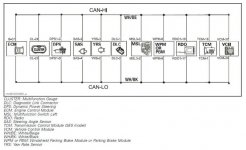IdahoMtnSpyder
Well-known member
There has been some misunderstanding here about what the Can Bus is and isn't on our Spyders, and what it affects. CAN refers to Controller Area Network. Can Bus generally refers to a communication protocol among various components on the Spyder. Here is a overview of the network.

Brake lights, tail lights, and headlights all are powered by 12 volt lines controlled by switches and relays. Turn signals are the only lights tied into the Can Bus, and then not directly. TS are operated by the cluster which communicates with the left side multi-switch via the Can Bus network.
Looking at the diagram you can see that all the various controllers communicate over the network, the engine, the stability system, the power steering, the radio, the left switch, and so on. But they do not all communicate with every other one. The engine doesn't talk to the MSL or the radio. But the MSL talks to the radio and to the cluster. The VSS talks to the ECM but not the radio. Nobody on the network talks to the brake light, but the brake light switch is one of the inputs to the ECM, which has as one of its functions cruise control. The engine and transmission talk to each other, and the MSL talks to the SE transmission module, which is how the shifting is controlled.
So you see, there is a lot of communication going on among the various modules, but only to the modules. The modules then control everything else, some by controlling power directly such as the turn signals, and some by controlling relays like the load shedding relay which is what controls power to the headlights, grip heaters, etc.
This is probably somewhat rambling and confusing to some, but hopefully it'll help us all understand the role of the Can Bus a little bit better. If I didn't make something clear enough ask away.
Brake lights, tail lights, and headlights all are powered by 12 volt lines controlled by switches and relays. Turn signals are the only lights tied into the Can Bus, and then not directly. TS are operated by the cluster which communicates with the left side multi-switch via the Can Bus network.
Looking at the diagram you can see that all the various controllers communicate over the network, the engine, the stability system, the power steering, the radio, the left switch, and so on. But they do not all communicate with every other one. The engine doesn't talk to the MSL or the radio. But the MSL talks to the radio and to the cluster. The VSS talks to the ECM but not the radio. Nobody on the network talks to the brake light, but the brake light switch is one of the inputs to the ECM, which has as one of its functions cruise control. The engine and transmission talk to each other, and the MSL talks to the SE transmission module, which is how the shifting is controlled.
So you see, there is a lot of communication going on among the various modules, but only to the modules. The modules then control everything else, some by controlling power directly such as the turn signals, and some by controlling relays like the load shedding relay which is what controls power to the headlights, grip heaters, etc.
This is probably somewhat rambling and confusing to some, but hopefully it'll help us all understand the role of the Can Bus a little bit better. If I didn't make something clear enough ask away.

